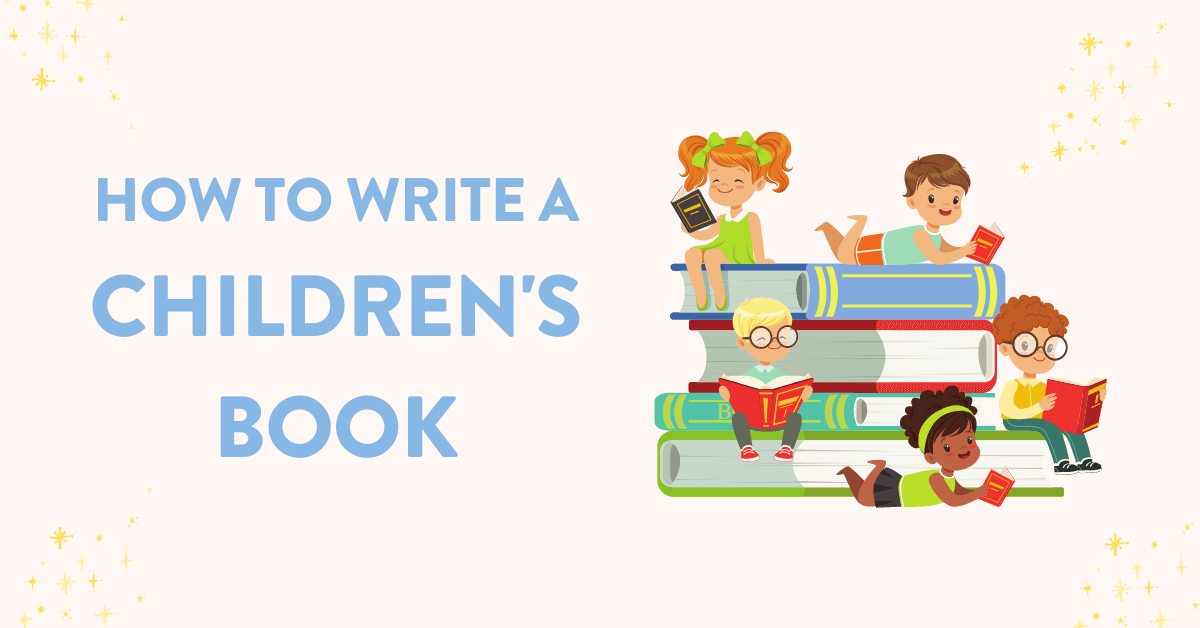
As a children’s book editor, I’ve helped hundreds of authors write, edit and publish their children’s book.
Anyone can sit down and dash out a children’s book, and with a little help and guidance, yours can be good enough to earn the attention of thousands of children.
And nothing beats the feeling of holding your printed book in your hands and reading it to a child for the first time. Follow these 12 steps and you’ll get there in no time.
In this article you’ll learn:
- How to generate a concept that works
- How to create a main character that children love
- How to write the right length
- How to structure the plot
- How to work with an illustrator
- How to revise
- How to publish
I also help authors with:
- Publishing your children’s book (with Bookfox Press)
- Editing your children’s book (big picture feedback, not just correcting commas)
Lastly, you can read this whole post and get a decent understanding of how to write a children’s book, but if you want the full, in-depth experience with even more information, videos, PDFs, quizzes, and exercises, you can take my 30-video course on how to write a children’s book:
Online Course: “Two Weeks To Your Best Children’s Book.”
Okay, buckle up and get ready! These are the 12 steps to writing a children’s book.
1. Find Your Best Idea

You probably have an idea already, but you should work on refining it. Here’s how:
- Google “children’s book” and a phrase that describes your book.
- Once you’ve found books that are similar, look at the summary of those books.
- Figure out how your book is different than the published ones.
This might seem commonsense to check what’s already out there before putting all your time and energy into a book, but so many authors don’t do it! This is just basic research that you can do in 2 minutes that will give you a sense of competing books.
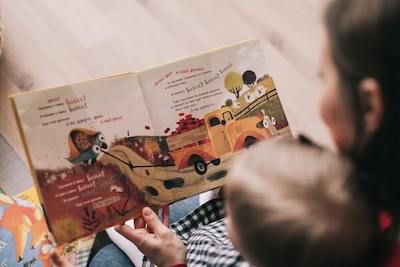
When I lead most authors through this process, they discover that their idea has already been written about. Now, that’s not necessarily a bad thing — actually, it’s proof that children want to read about their topic!
The trick is to have one twist for your story that makes it different. If it’s a story about bullying, perhaps your book tells the story from the point of view of the bully! Or if it’s a story about a dog, make this dog a stray or blind in one eye.
Maybe your story is different because you have a surprise at the end, or maybe it’s different because it’s for an older or younger age group, or your character has a magical guide like a fairy or elf to lead them through their journey. Just add one twist that distinguishes it from other books.
2. Build the Character
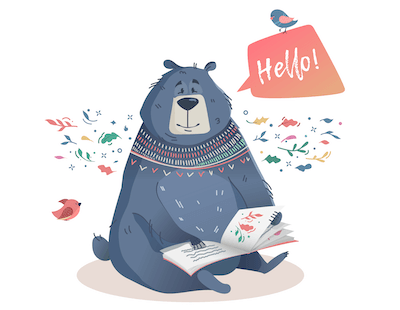
I edit hundreds of children’s books every year, and the best books have unique characters. They are quirky in some way. They have a funny habit. They look strange. They talk differently than everyone else.
But when I see a book where the main character is indistinguishable from every child, that worries me. You don’t want a character who stands in for every child, you want a main character that feels REAL.
My advice would be to go through a Character Questionnaire and figure out how much you know about your character:
- What does your main character desire?
- What is their best/worst habit?
- Are they an extrovert or introvert?
- How do they speak differently than everyone else? (cute sayings, repeated phrase/word, dialect, high/low volume)
- Do they doubt themselves or do they have too much bravery?
- Do they have any pets? (or does your animal character have human owners)
- What makes your main character feel happy?
- Do they have any secrets?
- What would this character do that would be very out of character?
- What is one thing this character loves that most people dislike?
Now score yourself on how many you knew right away:
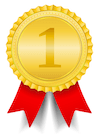
8 – 10
Congrats! Your character feels like a real person to you!

6 – 7
Pretty good! You have thought deeply about your character.
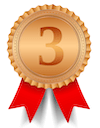
5 and below
Take a few more character questionnaires before you start writing.
If you’d like more questions, I have an expanded version of this questionnaire in my course.
I also have another post on the 10 steps to writing a memorable character.
3. Find the Right Length
What’s the right word count for your book?
This is probably the most common question I get asked, and it’s also the one that most writers get wrong.
Ultimately, you need to figure out what age range you’re writing for, and then write within that word count.
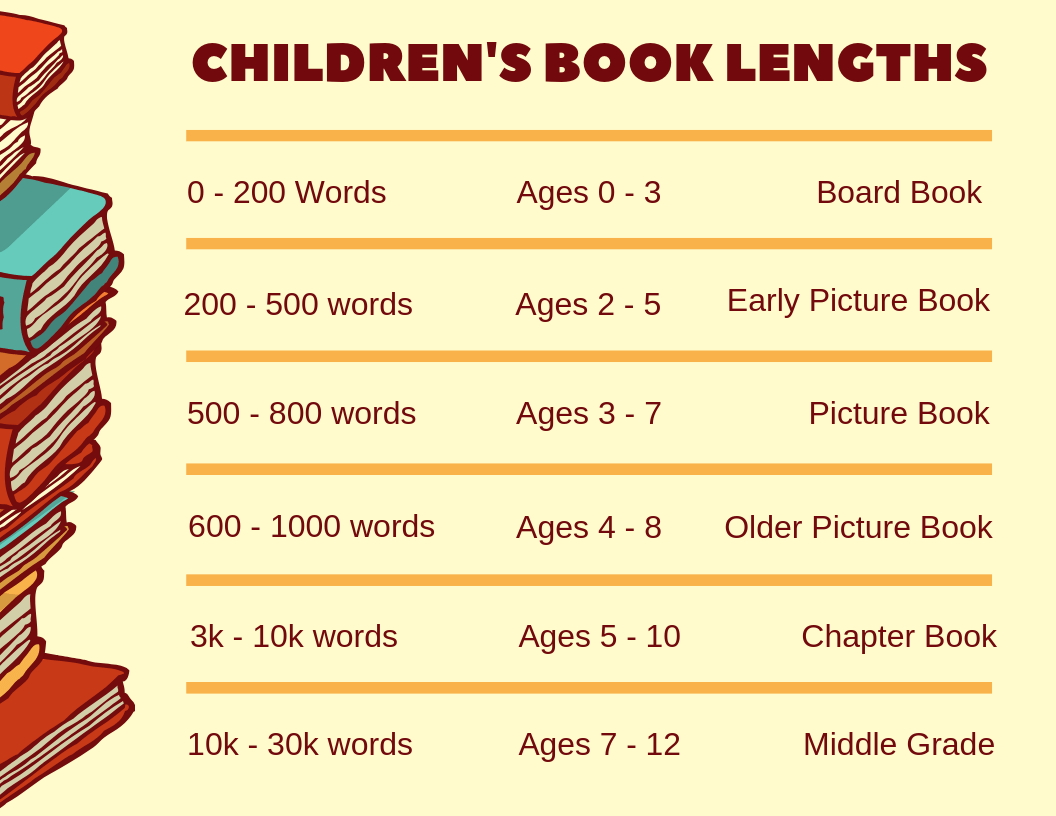
Most writers are writing picture books for ages 3 – 7 — that’s the most common category. If that’s you, then shoot for 750 words. That’s the sweet spot.
If you write a picture book more than 1,000 words, you’re sunk. You absolutely have to keep it under 1,000 words. It’s the most unyielding rule in the entire industry. Seriously, take out all the red pens and slash away until you’ve whittled it down.
4. Start It Quickly
Many unpublished children’s books fail to grab the child’s attention (and parent’s attention!), and that’s because they start too slow. If your story is about a child joining a circus, they should join on the first or second page.
Don’t give backstory about this child’s life. Don’t set the scene or tell us what season it is.
Just have the circus come into town, and as soon as possible, have the child become a clown or tightrope walker or lion tamer.
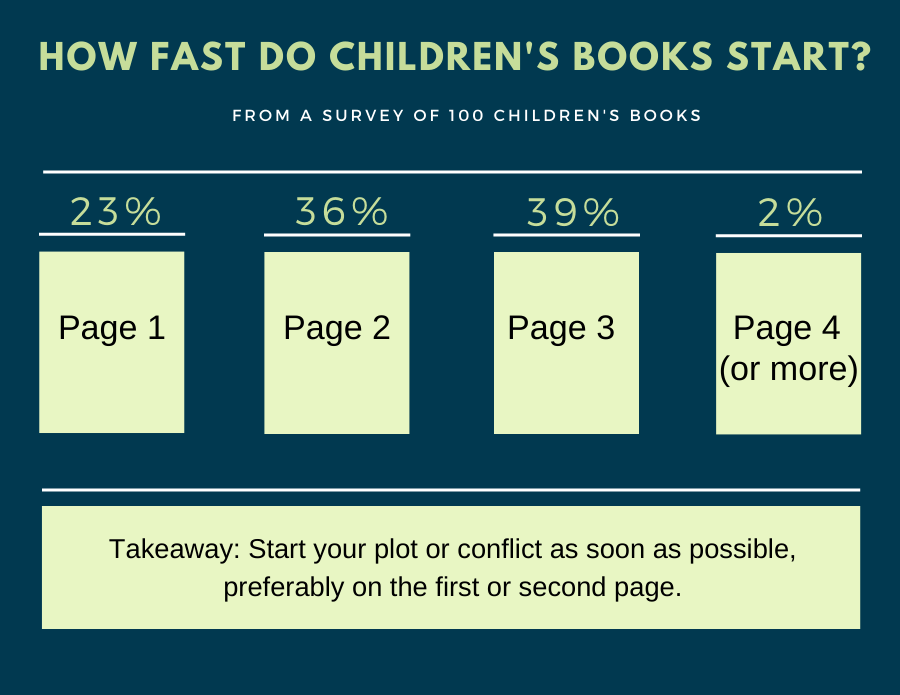
You have such a short space to tell your story that you can’t waste any time. The pacing of children’s stories generally moves lickety-split, so don’t write at a tortoise pace.
For instance, look at the picture book “HippoSPOTamus.” When do you think the hippo discovers the red spot on her bottom?
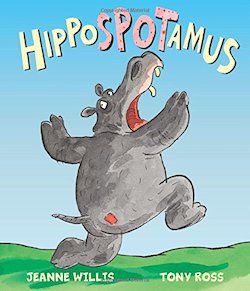
Yep, it’s on the first page.
And that event launches the entire story.
Start your book that quickly.
5. Create A Problem
Every character has a problem. It could be a mystery, it could be a person, it could be a crisis of confidence. That problem is what they will struggle with for the entire book.
The majority of the book will be obstacles the main character has to hurdle before they can solve their problem.
Here are the main mistakes beginning writers make with their character’s Main Problem:
- The character solves the problem too easily. Make your character really struggle and fail. Ideally, the main character should fail at least three times before solving this problem, and perhaps fail as many times as five (if you’re writing for older children).
- There are not a series of obstacles. On the character’s way to solving the problem, the main character should run up against a whole bunch of obstacles. Don’t have him defeat a single obstacle and then voila, problem is solved. To build a rocket ship to fly to space, the main character should lose some parts, his mother should call him for dinner, his friend should tell him it won’t work, it should rain, etc.
- The character doesn’t care enough about solving the problem. This has to be a HUGE problem for the child — they have to feel like it’s a matter of life and death, even if the actual problem is only a missing button. As long as the child feels like it’s a huge problem, the reader will feel like it’s a huge problem.
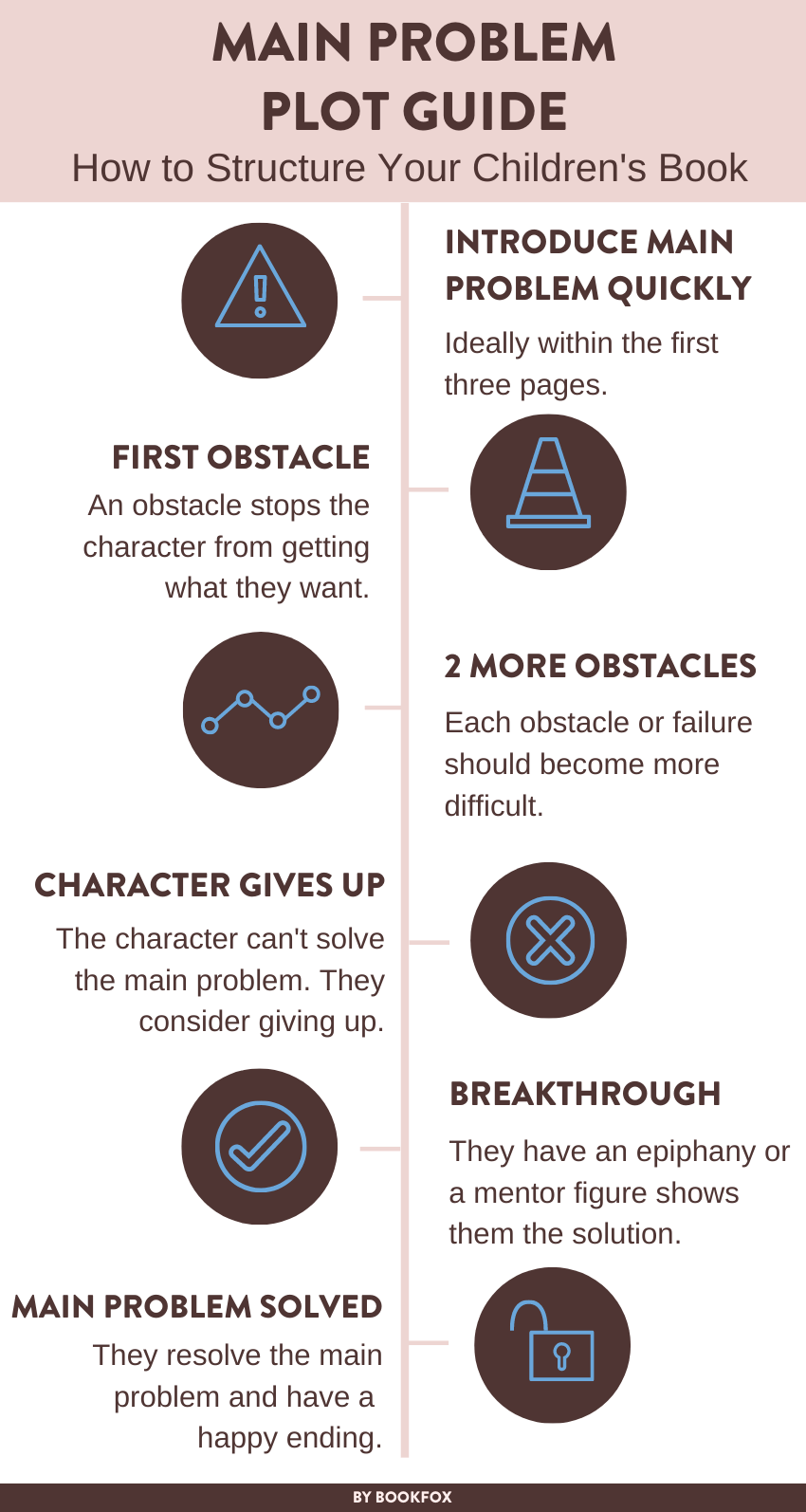
6. Use Repetition
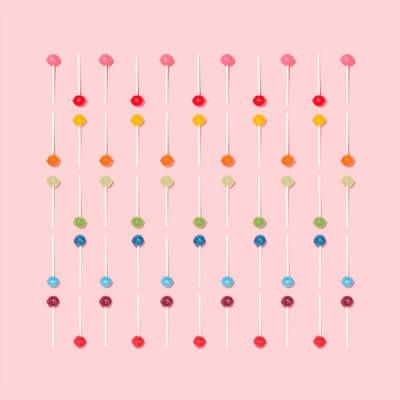
Children love repetition! Parents love repetition! Publishers love repetition!
Everybody loves repetition! (check out my post on 17 fantastic examples of repetition in literature).
If you’re not repeating something in your children’s book, it’s not going to be a great children’s book.
I mean, all of Dr. Seuss is basically built on repetition (and he’s pretty much the godfather of children’s books).
Here are three types of repetition that you can use:
- Repetition of a word or phrase on a page
- Repetition of a word or phrase across the entire book
- Repetition of the story structure
Any book that rhymes is using repetition of similar words, and I would argue that story structure repetition is even more important than language repetition.
Click on the image below to learn more about my children’s book course:
7. Write for Illustrators
One of the main jobs of the writer is to set up the illustrator for success (and at Bookfox Press, we connect authors with talented illustrators).
But so many writers aren’t thinking about what kind of material they’re giving to the illustrator.
If you have a book that takes place inside a house between two characters, the illustrator is going to struggle to draw visually interesting images.
A good illustrator can radically improve your book, but they’re also working with what you give them. So give them more:
- Choose fun buildings for your setting (put it in a greenhouse rather than a school)
- Think of funny-looking main characters (a lemur is much more fun to draw than a dog)
- Get out in the open rather than being inside (wheat fields are more entertaining than a bedroom).
Inside locations like a school limit illustrators:
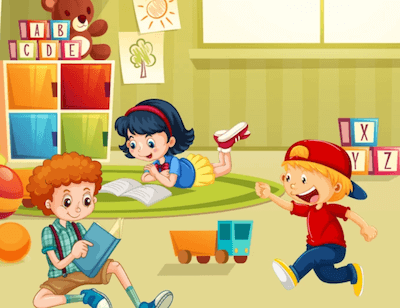
While illustrators have much more freedom with fun outside possibilities:
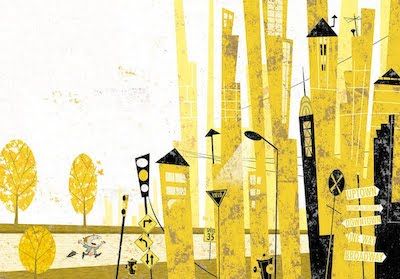
Remember, a publisher isn’t only evaluating your book on the words alone. They’re thinking about the combination between your words and an illustrator’s pictures. And if you don’t provide a solid half with the words, they’re going to say no.
And if you’re self-publishing, good visuals are much more fun for the child!
Also, if you’re exhausted by trying to find an illustrator that you can trust, and is affordable, let Bookfox Press do all the legwork for you. We have trusted illustrators that we’ve worked with before, and who do incredible work.
8. End the Story Quickly
Once the main problem of the story is resolved (the cat is found, the bully says he’s sorry, the two girls become friends again), you only have a page or two to finish the book.
Since the story is done, there’s no longer any tension for the reader, which means they don’t have an incentive to keep reading. So do them a favor and end the book as quickly as possible.
Basically, you want to provide a satisfying conclusion and wrap up all the storylines.
One of my favorite tricks for an ending is a technique that stand-up comedians call a “Call Back.” This is when they reference a joke from earlier in their set to finish out their routine.
You can use this in children’s books by referencing something in the first 5 or 6 pages of the book. For instance, if the main character was so focused on a purple lollipop that they wandered away and got lost, then after she was found the final page of the book might say: “and from then on she only licked red lollipops!”
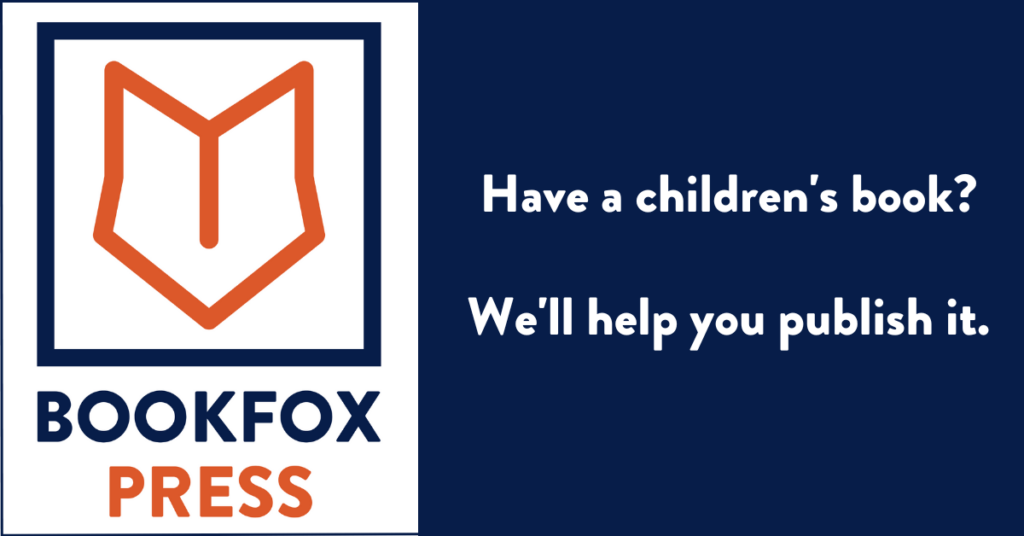
9. Choose Your Title

Now you may say: why are we figuring out the title after we do all the writing? Good question.
The truth is that many writers don’t know the essence of their story until after they write the book. So you can have a temporary title, but just know that you’ll probably revise it after you finish.
And revising is fine! Everybody revises. Don’t be afraid to change your title multiple times until you hit the exact right one.
Also, the title is the number one marketing tool of your book. Most readers decide whether or not to pick up your book from the title alone. That means choosing a title might be the most important thing you do (although it’s probably a tie with choosing an illustrator).
- Use Similar First Letters (Alliteration). Say your book is about Amy’s adventure finding a whole meadow full of poppies, and how she befriended a mouse there.
- Don’t Title: “Amy’s Adventure with Poppies.”
- Do Title: “The Mouse in the Meadow.”
- Don’t Use a Descriptive Title. Many people just describe the contents of their book in the title, but I would warn against this. For instance, there’s a book about a boy who is searching through a vast library to find a special book about eternal life. What would you title this book?
- Don’t: “The Vast Library.” (Boring)
- Don’t: “The Library Hunt.” (This is better. “Hunt” is a good word, and the combo with library is intriguing.)
- Do: “How to Live Forever.” (This is the actual title, and it’s great. This is the name of the book the boy is searching for, and it lets the reader know there will be some deep topics discussed.)
- Use an Action Title. You want energy in your title. A lackluster title will spoil your book’s chances for sure. That means you want fun active verbs inside your title rather than passive ones.
- Don’t: “Johnny’s Wonderful Day.”
- Do: “Captain Johnny Defeats Dr. Doom.” (Captain Johnny makes it more playful, we have the active verb of “defeat” and Dr. Doom uses alliteration.)
- Use the Technique of Mystery. Does your title tell the reader everything they want to know about the topic or does it provoke their curiosity? Your goal is to give enough information that the parent says, “Huh, that sounds fun.”
- Don’t: “The Bird in the Window.”
- Do: “Oh, the Places You’ll Go!” (What places?)
- Do: “Olivia Saves the Circus.” (How? We want to know.)
- Do: “How to Catch an Elephant.” (Tell me more!)
- Google “Children’s Book [Your Title]”.You want to see if the title is already taken (or if there is a title that is too close). Now say your perfect title is already used. Can you still use that title? Well, yes. People can’t copyright titles. But you’ll have a hard time distinguishing your book from that book, so it’s not always the best idea.
- Test Your Title with Children and Adults. It’s important to see how children react to your title. Are they excited? Do they seem bored? But remember that children aren’t the ones buying books — parents are. So make sure to bounce it off some adults as well and get their reaction.
10. A Revision Strategy
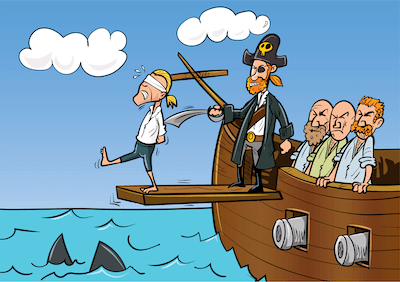
Most unpublished picture books are far too wordy.
In fact, if you talk to publishers and agents, they will say that children’s books being too long is one of the main things that makes them reject a book.
Here is a revision technique that will help solve that problem. Make every single word, every single phrase, every single sentence “Walk the Plank.”
In other words, you highlight it and hover over the delete button (this is the “walking the plank” moment) and ask yourself: if I cut this, will the story no longer make sense?
If the story will still make sense, then PUSH that phrase/sentence off the plank and delete it.
If the story will not make sense, then that word or phrase or sentence gets a reprieve (at least in this round of editing!).
In general, the shorter your children’s book, the better chance that publishers/agents will like it and the better chance you’ll have of pleasing children and parents (not to mention shorter books are cheaper to illustrate — and illustration is expensive!).
11. Find an Editor
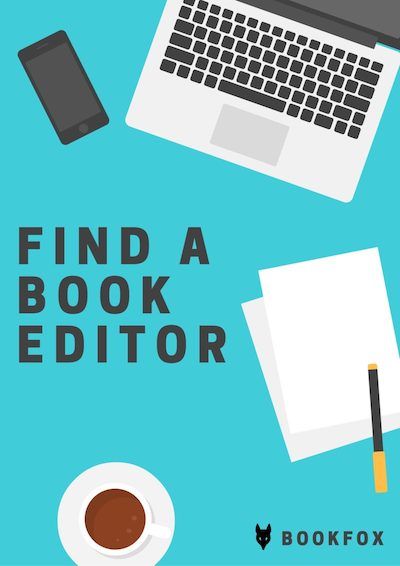
Once you’ve written your book, you really need to get an expert’s opinion to help you improve it. An editor will be the best investment in your book. After all, I know you love what you’ve written, but there are so many tricks and techniques to writing that can improve the experience of the reader.
There are two different types of children’s book editors.
- First, there are developmental editors (also called content editors). These editors help you improve the story concept, the plot, the characters, the pacing, the dialogue, and whatever else needs to be improved. They look at the big picture and help you revise your book (this is what I do!).
- After you use a developmental editor, then you would need a copy editor. This is the editor who fixes all the formatting, grammar, spelling, verb tenses, style, and all the other small details. They make your book look professional.
Sometimes you’ll find an editor who can do both, but you can’t do both at the same time — you have to make all the big picture revisions before you start tinkering with all the small details.
Here is a handy checklist when looking for an editor.
- Your editor should be someone who has been in the industry for a while.
- Your editor should have examples of published children’s books that they’ve edited.
- Your editor should have testimonials from satisfied writers.
- Your editor should be a member of SCBWI (Society of Children’s Book Writers and Illustrators).
The cost of editors vary widely, but if you’re not paying at least $400 – $600, you’re probably getting an amateur without a lot of experience in the industry. And you don’t want a beginner messing around with your book.
If you’d like to hire me as an editor, check out my children’s book editing page.
12. Find an Illustrator
This is the most important step of the post-writing process.
An illustrator will be the most expensive step of publishing a children’s book, but also the most essential for a successful book. The more you spend on this step, the better your book will look. Bookfox Press helps you out because we have vetted illustrators and you can rely on them.
When you’re considering an illustrator, this is what you should ask for:
- To see examples of previous work (do you like their style?)
- To see a copy of the contract (do they keep the rights or do you?)
- How long it will take (look at the graphic below for average times)
- Whether they also do layout, type, and book design (otherwise you need to hire a book designer afterwards)
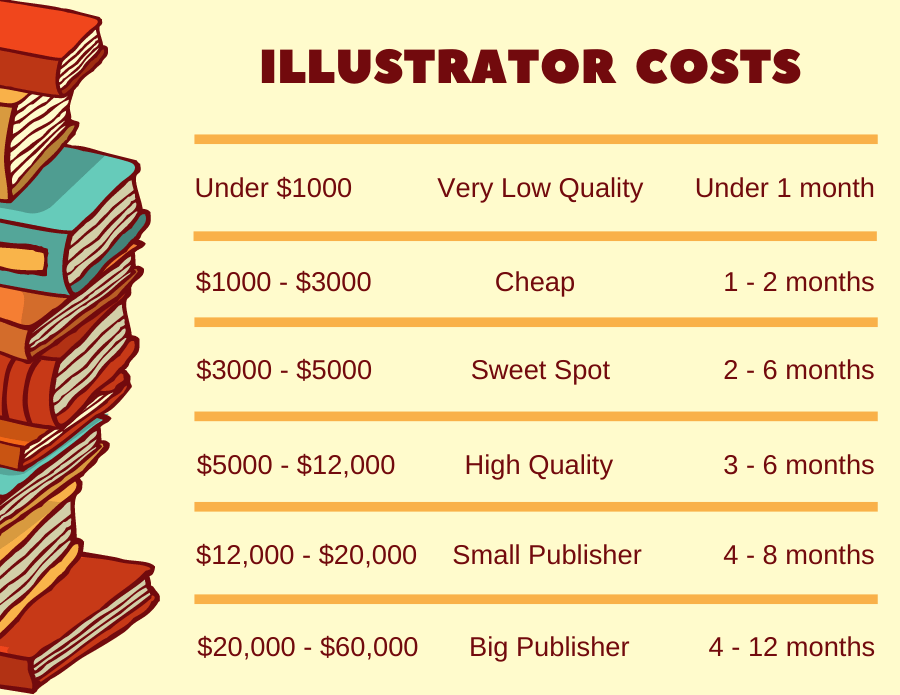
Make sure you’re really in love with the illustrator’s style, and that it matches your vision for what you want the book to look like.
WHAT FOLLOWS IS VERY IMPORTANT.
You can’t just throw words up on an illustration and expect them to look good. It’s essential to have a happy marriage between text and image. You want to think about:
- The font. This is incredibly important. I see a lot of self-published children’s books that selected the wrong font, and it’s glaringly obvious. You need an illustrator to help you choose exactly the right font to match the illustrations.
- The size of the font. This is important as well. It should be consistent across the whole book and should pair well with the size of objects in the illustration.
- The placement of the words. If you put the words in the wrong place on the image, you basically ruin the entire illustration. It needs to be carefully balanced and follow good composition guidelines like the rule of thirds. Ideally, the words should enhance the illustration rather than detract from it.
- Page breaks. What words should go on which pages? This is something you need to discuss with your illustrator before they begin. They need to have a say in this — don’t just tell them how you want the pages to be broken up. For instance, they might have the idea to have a two-page spread without any words at all, or to separate a single sentence across several pages, or to have one page with a few sentences on it and the next page with just a short phrase for emphasis. This is the number one mistake I see beginning writers/illustrators make: they have the same amount of text on every single page (usually a single sentence).
So either hire the illustrator to do book design, or hire a book designer. But just don’t choose the fonts and placements and font size on your own — get a book designer to help you.
If you want to learn more about how to work with an illustrator, check out my post, “12 Tips on Working with a Children’s Book Illustrator.”
Common Questions
Q: Should I copyright my book?

There are differing opinions on this, but in general I would say NO. You don’t have to worry about someone stealing your book. If you go the traditional publishing route, the publisher will copyright it for you. If you go the self-publishing route, you already own the material the instant you wrote it, so getting copyright only gives you added protection.
If you need more advice on this, read my post, “Should You Copyright Your Children’s Book.”
Now if you’re going to chew your nails down to the nub worrying about this, then set your mind at ease. If you live in America, go to the U.S. Copyright Office website and you can register for under a hundred bucks. I walk you through the steps on how to do this in my children’s book course.
Q: Do I need illustrations before sending my book to editors, publishers, and agents?
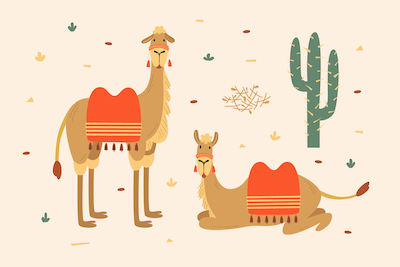
This is a hard and fast NO.
Editors want to work with the language alone, so unless your book requires the illustrations to make sense, you don’t want to send the illustrations. Even then, you can easily put the illustration explanation in brackets [like so].
Publishers always always always hire their own illustrators, so save yourself the money and submit the text alone. This is because choosing an illustrator is a marketing decision (that they need to make, not you) and because a good illustrator can cost $20,000. You probably don’t have that kind of money lying around.
Now what if you’re the illustrator? Well, then you DO want to send the illustrations. But if you get a rejection, it could either be because of the story or because of your illustrations, and sometimes you won’t know what the weak link is.
In general, though, agents are looking to represent illustrator/writers much more often than they’re looking to represent writers alone. That’s because children’s book illustrators earn A LOT more money than children’s book writers (sorry, that’s just the way it is).
Q: Should I ask for a non-disclosure agreement? (NDA)
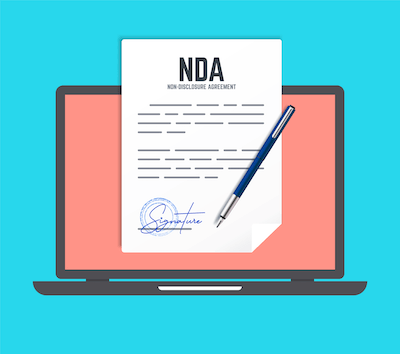
If you want to you can, but you have a better chance of a bear eating you than someone stealing your book.
Plus, if they steal it, you can easily sue them and take all the profits and more, so there isn’t much motivation for someone to steal your book.
The truth is that writers worry about this far more often than it actually happens. My advice would be to put all your energy toward creating the best children’s book you can create, and if you have a great book, the agent/publisher/editor will want to work with you, not steal from you.
Q: Will you be my literary agent?
No, I’m an editor, and the role of an editor and literary agent are very different. An editor’s job is to help you make your children’s book the best it can be. The role of a literary agent is to play matchmaker and find a publisher who wants your book.
However, if you sign up for my children’s book email list (via a pop-up on this page or at the bottom) I will send you a list of children’s book agents. Also, here’s another list of agents.
Q: Will you help me find a publisher?
That’s mainly the role of a literary agent, but I do have a list on Bookfox of 30 publishers who will accept submissions without a literary agent.
And if you hire me for editing, sometimes I’ll be able to recommend a few publishers where your book might be a fit, but it’s not like a handshake deal. Publishers get a large number of submissions and they have to take on the books they know they can sell.
Q: How many submissions will an agent or publisher get in a year?
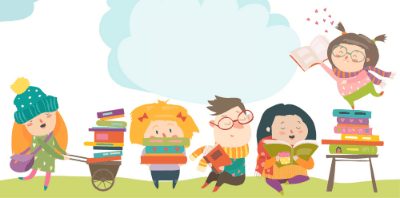
A beginning agent might get 2,000 – 3,000 submissions in a year, while an established agent might receive 3,000 – 8,000 submissions.
Publishers who accept submissions get anywhere from between 2,000 submissions to 15,000 submissions, although almost all publishers who start getting too many submissions stop accepting submissions (because it costs too much to hire people to wade through all those submissions).
I don’t mean to discourage you, but just help you make an informed decision about whether you should self-publish or seek a traditional publisher. It’s really tough to land an agent or a publisher, and it can take a lot of time and work.
What’s wonderful about self-publishing is that within a week you can be holding your book in your hands.
Q: Should I self publish or seek a traditional publisher?
So for self-publishing, there’s lots of upsides: there’s no wait time, and you get complete control of the project (such as cover art and illustration), and there’s not that much of a cost if you do it all yourself.
But … you have to do all the marketing yourself, and you don’t have anyone to guide you through the process, and you don’t have the reputation of being published by a traditional publisher. You should do self-publishing if you’re a real go-getter and you think you can get the word out there about your book.
For traditional publishing, there are also many upsides: you would get an advance (money is nice!), they would handle all the proofreading, ISBN, illustrations, cover art, etc, and they would give you some guidance with how to do the marketing and promotion.
But … it can be very, very hard to get an acceptance from an agent or from a publisher. Sometimes you have to send the story out for a year or two, submitting to a hundred outlets or more. Go this route if you have a lot of patience and you want the book to reach a wider audience.
Read my post on “How to Self Publish a Board Book” if you want more info on that.
Did you want more advice on how to write a children’s book?
So let’s review the 12 main points:
- Find Your Best Idea
- Develop Your Main Character
- Write the Right Length
- Start the Story Quickly
- Figure out the Main Problem
- Use Repetition
- Write for Illustrations
- End the Story Quickly
- Choose Your Title
- A Revision Strategy: Walk the Plank
- How to Find an Editor
- How to Find an Illustrator
Please leave a comment below if this material was helpful and if you have any other questions.
Also, please check out my:
- Children’s book course — “Two Weeks To Your Best Children’s Book”
- Children’s book editing — let me help you with your book.
- Children’s book Publishing: Bookfox Press

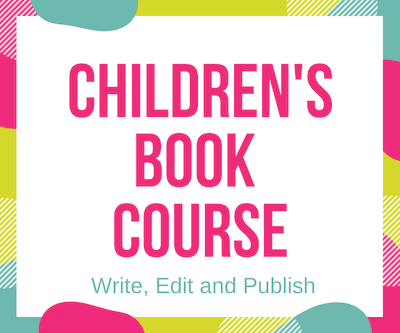
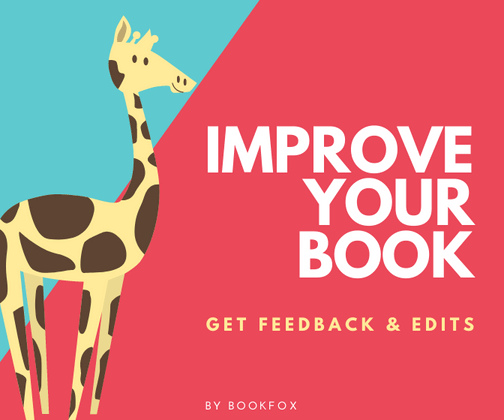
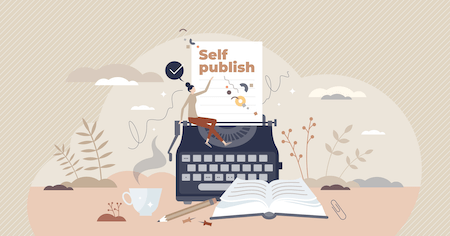
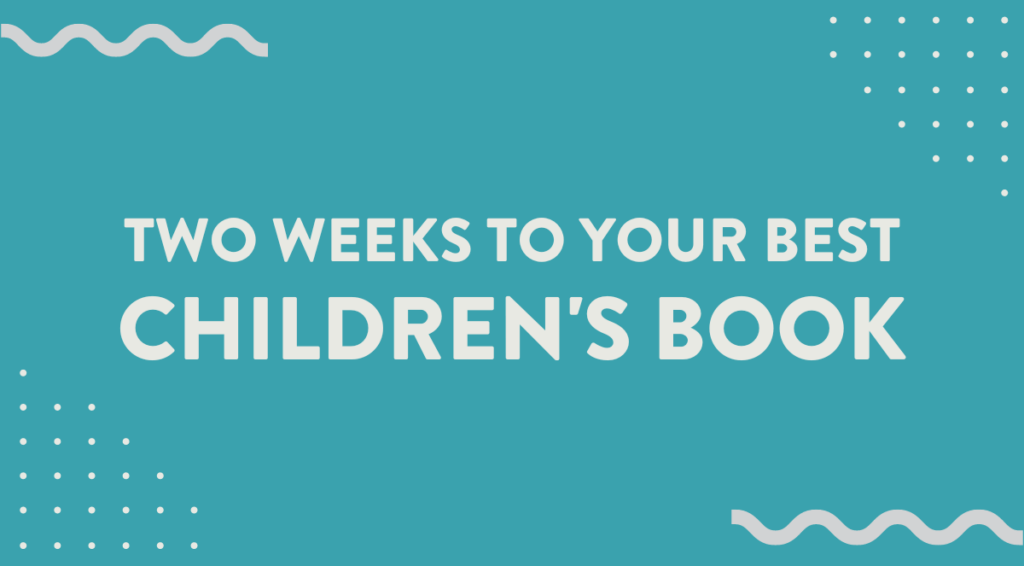
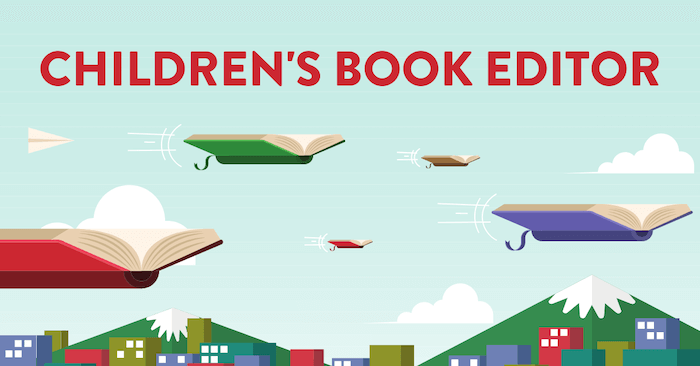



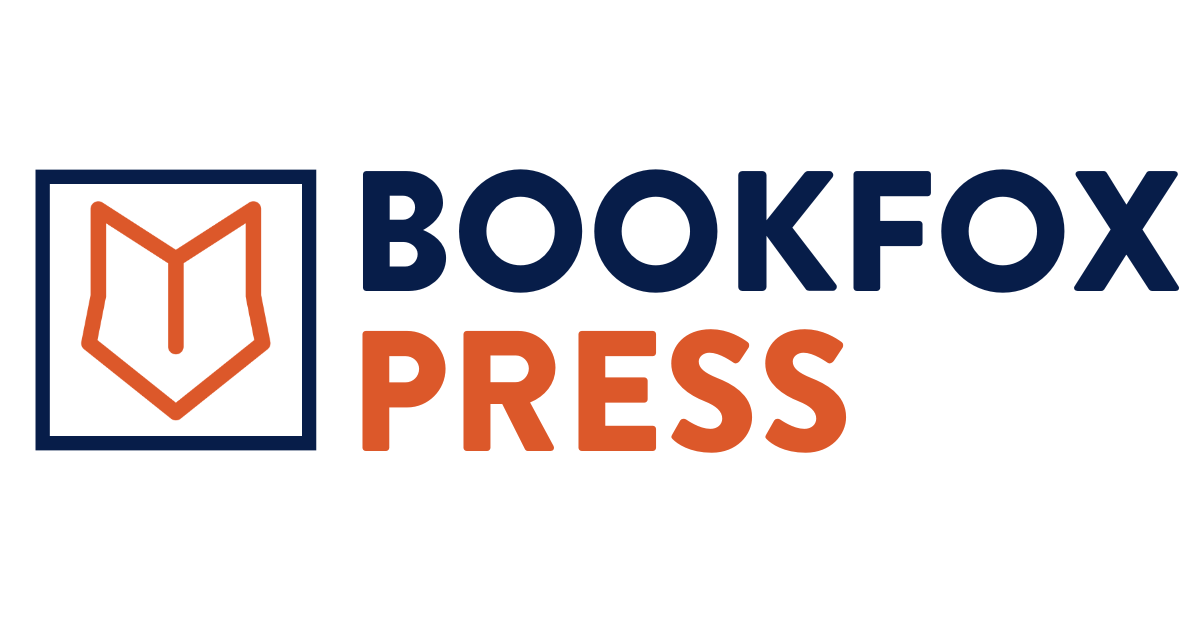
356 comments
This is a good article
Brilliant article. So much I never knew
The best article I’ve found on the internet on writing for children. Superb job!
This article is fantastic. Straight to the point and very clear. Thank you
I found the article to be full of good information, it gave me a lot of insight into writing a children’s book.
I searched Google on how to write a children’s book and this is by far the best information…Really helpful
Hello,I wrote a children’s book that will be a series. It’s a killer name and character.I need help and guidance cause I wrote a short story too and need a editor.
Thank you for the time you have taken to write this article. It is very informative and has given me some great tips for starting out.
The most profesional of all the articles i have read! Thank you!
Thank you…this helps me tremendously
This article has been very helpful.
Thank you for this article,it is very detailed and comprehensive .It gives a very structured insight on how a story becomes a book. The story behind the story.
Thank you a great article. I will try self publish Amazon, I have written this children’s book/true story and will illustrate as I’m a graphic designer… I can only try
Thank you. It was absolutely illuminating!
I am writing the first book of a series. Do you have any tips for this particular genre? Ie. Franklin the Turtle, Clifford, the Big Red Dog.
Wow! THANK YOU for writing this. I have always wanted to try writing children’s books. Now I know where to start. Thanks again, this is incredible.
This was so helpful for me. I am very interested in writing a children’s book. Thank you for the advice.
Professional advice for free. I am inspire, thank you for helping me structure my thoughts into something worth daring to start.
This article is so interesting and really helpful.
I have a question though…. I’d like to write a book,my grandchildren are my inspiration for this!. Is it possible/usual etc to write a series of books for children to read at age 4 but grow with them til around age 10, so each book in the series is for the next age group, if that makes sense.
thanks Clare
Great article I! Very helpful!!.. I have subscribed to your email list.
I agree. You gave me lots of things to think about from many different perspectives as I embark upon this adventure. Thank you so much!
Great article
Quite a good article for the beginners.
So incredibly helpful!! Thank you for your insight.
Great insight on the book writing process, from start to finish. Thank you.
Very helpful and well organized! Thank you for your insight on the writing process!
Amazing article! I’m in the process of editing my 4th draft; after that, I will be looking to hire an editor and illustrator. Thanks for writing this !
This was soo insightful and inspiring. Great guidance for my book writing
Oh, come on. Good article? No. It’s a GREAT article!
One of a kind that has quality and depth to it. This is advice borne from experience. I’ve written quite a few books for kids and this is the best breakdown of the picture book creation process I’ve seen in a long time.
Very generous too.
So sit down, get a cup of tea, and read this through – many times.
Until it sinks in.
Then do what it says. (Essentially: Quality children’s books only get written when you, the author, have something worthwhile to say. And when you say it in a way that engages, inspires and entertains young readers.)
I agree -very generous, thank you!
Thank you. I have been hired to illustrate a book which is very challenging. I am also anxious to start my own. My ideas have been brewing and now it’s time to make them a reality. Your advice is great. I’ve been studying hundreds of children’s book illustrations. Some are incredible works of art! That’s the goal.
Thank you for this great info that makes me excited to get started. Im only at the idea stage so along way to go but I am excited!
Thanks for your good comments which was very helpful specially for anyone who is a begginer in this field.
This article is a godsend!
Yes, great article, inspirational and also a call to action…just what’s needed. Now, back to work people! 🙂
Thank you for this post. I am an author and illustrator who has published a kids book. And there is a lot of time consuming work involved. Word choice and the correct placement of illustrations is so important it’s not even funny.
I think that many people believe that children’s books are easier to write, because they’re for children but they’re not . Like you’ve shared, they should be written according to age group. And they have to be very engaging because they’re heavily illustrated and if the cover’s no good, no sale.
This is truly a great article to read and I was really hooked.
Joslyn, I agree with you that if the cover and word choice are no good then it is a no sale. As a Librarian when selecting books to purchase for the library, it is compulsory to select covers which are eye catching. Additionally, children are excited when they see attractive illustrations with fantastic colour schemes, intriguing characters and unique settings.
I am about to write my first children’s story book and I hope to draw from my experiences from spending 5 years living in Japan.
Thanks for sharing and best wishes.
Wonderful article! Extremely informative (I even took pen and paper notes) and it covers components I had no idea about nor would have even considered (first time writer here). Thank you for the point blank honesty and clear, detailed guidelines!
Same!
Wow! This was an amazing read. I’m so happy that I stumbled upon it because I learned so much! Thank you for being so thorough and transparent!
Great article thanks for sharing this info. Structure stuff is really interesting
Thank you so much. This article is very useful and informative. 🙂
This was very helpful. I have just written my first children’s book and found this article really insightful for what I need to do. Thank you
Goal: Have my HS kids write, edit, illustrate, publish a book in 180 days! Any further suggestions about pacing, clumping tasks, etc. would be greatly valued!
Absolutely fabulous article! Thank you!
Very helpful!!!! I’m starting with trying to self-publish a book my 10 year old granddaughter wrote, but after reading this and with your kind of help I may get inspired! Thank you!
I’m so glad I found your website! Thank you for this in depth post!
Lots of great info. Thanks! It really covers fiction well, but would love to see more info on writing (fun) non-fiction for kids.
very helpful
Great article. Although I have published 20 picture books, I still picked up many pointers. Thank you for your generosity. Beryl
Absolutely helpful, informative and I appreciate it.
Amazing Concept, Its very helpful for us.
This is amazingly beautiful, an article.
Thank you for sharing!
This is amazing information. I have thought about writing children’s books for years. Maybe it’s time I actually do something.
Hi, very good article, had a lot of information I never thought about before.
I’m interested in writing my own children’s book but I’m 20 years old and probably won’t be able to afford agents, editors and publishers. Do you k ow how much these cost as most publishing websites don’t include costs. Also is there writing grants you can apply for?
Thank you
Clare
So agents are free up front (they only take 15% of whatever you make).
Publishers are also free — both traditional publishers (they pay you) and self publishing (it’s free on Amazon, and other companies that require money are kinda scammy).
If you want to get an agent or a publisher, though, your book has to be good, which is why you should save up for an editor.
Hi, I wondered what the format is for the video course. Is it in DVD or access to on line videos? Thanks, Ellen C.
Hi Ellen, the videos are all online. I don’t offer DVD access. Hope that works for you!
Excellent article, thank you
Thank you for the information. Much appreciated.
Very helpful indeed, almost finished my first childrens, was interesting to know how illustrations receive more money than writers, I’m doing both. Thank you. Dont have a website yet.
Excellent article. I am sure–without a doubt–your content will be helpful to a lot of writers. Thank you for being brave enough to share your wisdom.
This is a great article one that I need to be able to start writing a book intended for children. Thank you for sharing it.
I am getting ready to get the ball rolling on my first children’s book. I was amazed at all the things in this article that I hadn’t even thought about!
What if your husband or son, who are fantastic artists in their own right, want to be your illustrators? Does that fall under editors wanting to promote illustrators/writers?
Sometimes they’ll take on a team of an illustrator/writer. You can always try.
Thank you for this article- very helpful. I’m wondering if it’s appropriate to attempt to self-publish while submitting to publishers and agents? Would a publisher not want to touch a project that is already being marketed in some other way?
Hi Benjamin, So once you self-publish, no publisher wants to touch it. It’s either/or — you can’t do both.
Excellent article and so generous that I just signed up for your video series which was reasonably priced. I’m a best selling author but my first time at a children’s book. I’m confident I will learn from you and may call on you for editing.
Thanks, Linda! Glad it was helpful and I know you’ll love the course, which includes so much more material beyond this little brief post. 🙂
Let me know when you’re ready for me to edit your book!
Hi Linda,
I am a big fan of your book, Solutionaries: You Are the Answer. Hence, I am reading John Fox’s article. I teach students with Autism and aspire to publish an educational book to create a positive impact in schools, at home, and in the community– one book at a time. Thank you for your beautiful mind. You’re an inspiration!
Sincerely,
Flor G.
This article was so helpful. I’m based in Canada and I’ve just written my first children’s book…I’m definitely at the editing stage but I’m considering the traditional publishing option. I would love to work with a Canadian publisher. Can you recommend?
Hi Cindy, I don’t have a list of Canadian children’s book publishers specifically, but I do have a list of 30 publishers looking for unagented submissions.
I would love your opinion on writing an educational children’s book. Would all the same principles talked about in this article (which was WONDERFUL, by the way) apply? Thanks!
Hi Emma,
Thanks, glad you enjoyed it! I would think almost all of them would apply, absolutely.
There are some additional considerations with an educational book — is the teaching too heavy handed, what about the balance between fun/learning, is there a moral in addition to the learning — stuff like that.
And you definitely have to nail down the age range for a book like this, and target it to exactly what they’re learning in school.
Hello John,
Do you think it is possible to get published in a traditional way in the US for someone who is not a citizen and lives elsewhere?
Thank you so much!
Yes! Definitely possible. But some of the time it’s better to look in your own country first.
Very helpful article. Thanks for sharing your wisdom. I have written four books, but never a children’s book.
Great article, I’m going to read it again and again as it covers many helpful points, thank-you!
Hi. I am an author using Amazon/Kindle. I have 11 books in different Editions. https://www.Tom-the-Atom.com is my web site and amazon.com/author/tom-the-atom.com my author’s page. Looking for a publisher on-demand to publish my book in hardcover and thicker pages. Also looking for an agency that helps to promote my books, If you offer such services please contact me. My books are copyrighted, have a Serial number registered at the Library of Congress ISSM and an ISBN number given by Amazon. The Series is Non-Fiction Science Books for Children: parents, baby to 12 years old.
Hi , I am a daughter of Holocaust survivor and my father wrote a book about it. I would like to write a children’s book based on my father’s memoirs. My father saved my cousin from a ghetto, she was only 4 years old so there is a story to tell that might appeal.
I need some guidance before starting this project … can you help?
Great article, thank you! I’m at the very beginning (thinking about it!) stages of writing a children’s book and this article has given me much perspective!
Great content and well articulated. Thank you for bringing it all together.
What an awesome article! I’ve been toying with the idea of writing a children’s book for years (I’ve had a title in my head for far too long) but never had the courage to attempt it – you’ve inspired me.
Can I just ask, once a book is written, approximately how long does it take to go through the editing/illustrating/publishing? I know there’s a lot of variables, I’m just wondering if you could give me a ball-park figure?
A lot longer than you would think. If you’re referring to traditional publishing, it can be a year and a half. Self publishing can be much quicker.
I was thinking around a year, so I wasn’t too far off. Thank you so much for the excellent information you’ve provided here.
This was very helpful! I plan on printing it out so I can go back over it in depth.
What are your thoughts about Amazon’s e-book publishing?
Also your input on using Fiver?
Fiverr can be a great source for cheap illustrators.
Amazon’s book publishing is great, but only publishes soft cover books. If you want hardcover, you need Ingram Spark.
Wow!
Thank you so much for writing this article, it’s honestly helped me see writing in a different form.
There are so many articles out there that only enhance the fact of beginning, middle and end, but you have literally dot pointed how it works and how each individual piece should be written, you have really done an amazing job at dissecting children’s books into a more understandable format!
Now off to writing!
Extremely helpful! I’m illustrating my grand daughter’s book for children. It’s not that easy. But with your guidance I think we can make it work.
This article is an absolute godsend for my UK Year 8 Creative Writing club. There is a wealth of good advice, generously given. Thank you so much.
Thank you for this post, it’s very insightful and informative! I’m more determined to start my book after reading this.
This was very very very helpful as I am a beginner in writing children’s stories! Looking forward to enrolling for your courses!
Thank you very much!
Hi Faith, Great, glad this was so helpful!
The course includes a ton of information that I didn’t have time to mention here, so I hope you enjoy it.
Wow. Thank you so much. So helpful for me. Thank you again and again and again. Now I know why I always think I’m not ready to go beyond thinking and writing the first draft. I need to know more, but honestly it’s the best article I ever read about writing. Thankssss. God bless you.
Great information, thank you. But you do assume that every children’s book is going to be a fictional story. What about if it’s an educational book in some way? No need to answer, just something to think on. All the same, there was a lot I could still take from this.
Who says educational books have to be nonfiction? Fiction can teach quite a lot. And if they are nonfiction, you still need a structure for them, even if it’s not a narrative structure.
Great article, thank you!
Extremely helpful information! As a self published author who also started a publishing company, I can attest to the time, talent and treasure required to be successful in this arena. Thank You!
Wow this information was so helpful! I’ve been wanting to write a book geared towards medically fragile children. This article gave me the reassurance I needed to stop doubting myself and just get started!
Thank you
It’s very informative and useful. Thank you for sharing! I’m on my way to the first children book with self-publishing. Been trying to offer it to publisher some last few months, but still no news yet. So, I’ll try self-publish this time. Thank you!
Thank you for all your hard work to keep us informed. I’m a French author for children and would like to sell my books in US. My publisher thought we could work with Amazon but they do not print landscape books. Any tips? You can see my work at https://marinaanca.wixsite.com/ancamarina
Try Ingramspark.
Hi,
I’ve just read your great post and I have a question. You have stressed how important an illustrator is and while I am not a professional illustrator I am an artist and really want to illustrate the book myself with a unique multi media technique. What are your thoughts on this.
Thanks, Wendy
Well, you can give it a shot. Worst the publisher can say is no.
Could I be my own illustrator or do I have to hire an illustrator? I have many ideas for the art in my book and I have a specific style I want.
If you’re good enough, yes, you can be your own illustrator.
Thank you very much 🙂
Thank you for a thorough article.
I am an English learner and my dream is to publish an educational book. I am sure you can help me achieve that dream.
As per the article, I would need an editor/quality illustrator/publisher, but I am financially incapable to do so. Which one should I invest the most in? Any technical strategy on this?
Also:
– how many times can I resubmit my work to a publisher or self-publish the same book (after multiple no’s)?
– If I submit my book to a publisher and not hear from them for over 2 years, can I self-publish instead or it will be revoked?
– Say I received the manuscript from you with your corrections, is there any additional charge for resubmitting the revision?
Hi Cefie,
You’re welcome for the article! Publishers don’t cost anything — you can self publish for free. Split your money between an editor and an illustrator. Find a cheap illustrator on Fiverr.
You can only submit to a publisher once. After they have passed, don’t send it again. (not answering means they don’t want it).
If you haven’t heard from them in 3 months, consider it a NO.
So when I edit, I give you a lot to revise and a lot to think about. But if you did want to revise and resubmit, I’d charge a discounted rate for another round.
Great Information there. I am from Kenya. I love children’s books and my 7 year old son loves to read. I have been having so many ideas about children’s books. Your article has really enlightened me. Thanks for sharing
This is the best information on writing children’s books that I’ve come across thus far. I am researching tips/ideas and am at the very start of my journey. Thank you so much, I really appreciate these awesome nuggets!
Hi LaTanya, great, glad you liked it! If you want a lot more information like this, my course doesn’t overlap with the information here and you get a lot more.
I’ve written a chapter book about 11-year-old characters. It’s almost 70,000 words. Is this too long?
Hi Lori, 11-year-old characters are MG (middle grade), while this length is more appropriate for YA (Young Adult), ages 13 – 18.
Ideally, a book for this age would be more like 40k to 50k.
I really appreciate this article.
Amazing article! So informative, helpful and easy to understand for first time writers.
Thank you for taking time to write, this article and for providing comprehensive information without charge. I will definitely look to use your editing services and course when ready.
Thanks again. 🙂
Great guidance and more than enough information to start a successful children’s book! Love you for this!
I have an idea for a children’s book series. Do you indicate that a series is the intent when you submit your work to potential publishers?
Thank you for all the great information!
Yes, I’d recommend that you include that information up front and if possible tell them you have the next two books written (if these are short picture books).
I am based in the UK – I am assuming I can still sign up for the course as the content will be transferable to those writing outside the USA? Thanks
Hi Kirstin, Yes, the content will work worldwide. There are only one or two videos that have US specific elements, but you can easily find the agents/agencies that are appropriate in the UK.
This is a fantastic post! Thank you so much!
Great article. Very informative and answers a lot of my questions. One element I’m still confused on is exactly who types the manuscript into the book? I have an illustrator who has done a lovely job of illustrating my idea. I’ve also hired a book designer who will create the fixed layout book for me to upload to distributors. I thought I was ready to send the book to them at this time but now I’m confused again. Should I ask the illustrator to insert the manuscript or does the book designer do this? I’ve written and published novels without illustrations in the past but a children’s picture book is an entirely new experience. Let’s get technical, please. (re the website – its a work in progress)
It depends on the agreement you have with illustrator or book designer. Most of the time illustrators will do it; it’s more rare for book designers to do it.
I was wondering, in general, what tense works best for a children’s picture book, Past or Present?
When in doubt, always use past tense.
You need a very good justification for using present tense.
This is such a helpful and realistic step-by-step article. I really learned a lot when reading it, so I know your course would be amazing. Looks like the next step after reading this is to take the course! Thanks for sharing your knowledge.
Yes, I hope you enjoy it! I made sure the course doesn’t just repeat this article — it provides a lot of info and techniques that I didn’t mention at all here.
This is absolutely an amazing article . It gave me a lot to think about . I love the step by step explanation, especially since I have never written a book before.
¡Bravo! Thank you for writing this organized, to the point, article. I learned a lot about working with my creative side and how to make a dream a reality. ¡Gracias!
Wow! Very insightful article and information provided. Thank you
The article is very, very helpful! I”m writing my first children’s book so i really needed this to help me get started.
For the 3-7 category (750 words), how many words should go on a page?
That’s a conversation you have with your illustrator. There’s no hard and fast rule. Sometimes no words at all. Sometimes a paragraph. Sometimes one word or a phrase.
It all depends on the vision your illustrator has for the pacing and images of the book.
This is absolutely a wonderful article . Thanks for sharing.
This is brilliant! The way you support your points by specific examples is eye-opening! Thank you so much! Love from Sarajevo!
I want to write a true story about my daughters dog and how the dog helped her with depression. However the dog’s name is Polly but we call her Popo. So is my title of “Popo saves the day” or “Better call Popo” going to be a huge red flag because Popo can mean police officer. Some site say it is derogatory but others say not. Its a catchy name.
I took notes for every paragraph I read. This article was very helpful to me and I can’t wait to finally begin my journey.
Great article. Very informative. I am an artist and I just completed my first children’s book. I am editing and doing the illustration work now, in watercolor. I don’t have the funds to go the expensive route, so I will probably self publish. Are there better methods or sources for self publishing.
Put it in a PDF and upload to Amazon. It’s free.
And let me know if I can help with editing before that point.
Excellent article. I appreciate it so much.
I’m so glad I found it.
After reading valuable advice from this article, I wrote my first book https://amzn.to/2zovXxJ ,
the book is in a scientific version for children, but considering the beginning of my adventure, I am happy.
It’s great that you share your knowledge.Thank you
Hi and thank you for this information! I hope this isn’t a repeat question but can you tell me if it’s best to have my book edited and then sent to a literary agent or can you go straight to a literary agent? I’m noticing all the publishers I’m looking at won’t accept unrepresented work, so it seems I have to use an agent. Would that be right?
The reason why authors get editing is because it’s extremely challenging to get a literary agent. You’re competing against hundreds of other writers for a single slot, and you want to make sure that your book is the best it can be.
Most big publishers only accept books from agents; small publishers accept work directly. Both are extremely competitive.
This is a very good and timely article. It will go a long way in helping me do my semester project work in the University.
My friends and I are all kids, and we’re in a club together writing books. I shared one of the images in your article with them (the main plot guide) and it’s been very beneficial to all of our novels. Thank you so much for writing this!
Excellent article!
I was wondering if there is any sort of common understanding of the publishing industry regarding the particularities of the book for each age group. I’m finding it rather difficult to define an age group the book aim to reach. How precise should I be, and how should the language adapt? Should I try to use words and expressions already knew by the children, or can I catch their attention by using a few new words?
Most of the time authors use language the children know, but some authors want to stretch their vocabulary by pushing it. Either is acceptable, though it’s probably harder to pull off the high diction level vocabulary.
It’s not just about language, though. It’s about length, about the intensity of conflict, about the type of problem, and the complexity of the plot. So it’s more like art than science to figure out your age range.
Hi, great article, I just have a question I’m writing children’s book for my school project and it must be completely done by august, printing, writing, everything and I’m on the writing stage. Since its a school project, do I need to publish it and have an editor and everything, from what I know, I can just make my book by myself completely and print it out because its nothing fancy and I don’t plan on having it sold on markets and things. How long do you think this whole process will take? and how long does it take to get a book printed, I don’t need a lot of copies, just around 1-5 maybe. This article was a great read but I don’t which of these tips apply in my case because Im writing a simple children’s book for a school project.
Hi Miya, for a project like this that you don’t intend to sell widely, you probably don’t need to hire an editor. You can make your book yourself, and if you put it into a PDF and upload it to Amazon, then you can buy a few print copies from them.
Great help and advice
I’m a grandma writing my first book, or trying to, so i found this information very helpful. Wish me luck, thinking going to need it!! … thanks again for all the info
I am also a grandma attempting to write my first book. Thank you for this information. It is helping me greatly. Please be in prayer for me as I follow God’s lead in His wisdom and guidance as I write this book. Thanks!!
Super helpful information – thanks for your generosity!
Loved this article. Well written and inspiring
Thank you so much! This was very helpful and informative.
Very helpful article. Thanks for sharing your wisdom. I wrote my first book on kids
Hi John,
This is great advice for beginners like me. It’s the first link I clicked on when I googled ‘how to write and illustrate a children’s picture book 2020’ so you must be doing something right! Thank you so much 🙂
Hey, thanks a ton for sharing this amazing guide on the ways to write the books for the children. One of my friends has just started writing children’s books and I believe this post will be of great help to him.
This has proven extremely useful. The content is well-written and easy to follow. Thank you !
This article was awesome, very informative, I loved it. I’m ready to get started writing my book right now. Thank you so much.
Thanks, this is very well-written!
Writing for children involves a lot of considerations: consider what children like; what they would feel; how they would read your book; and more.
Thanks for the great article, it really helped me focus on my idea
Excellent advice, and great that you are sharing it!
really a good article for beginners. Looking forward to finishing my first book and then will start the struggle to find a publisher. Thanks
Hi there, I’m wondering what the best format is to submit a childrens book to an editor is? How should it be laid out? In word? In powerpoint? Would love to get your input! Thanks 🙂
Word would be best. Keep it simple.
i love this. I’m a kid and i want to be a writer. i have written my first book and i need an editor so it can be published. I love this article so so so so so much
Hi, great article. Can you please provide advice/ tips on bilingual books?
Thanks for the article. It was really helpful.
Is it possible to self publish first and then publish again with other publishers? I wanted to write a book based on a personal story and give as a gift, but I thought the story also has potential. I would like to do own illustration and design, and it sounded like self publishing will give more flexibility.
No, once you self publish you can’t publish with a publisher, unless you sell a gazillion copies and they come knocking.
Thank you for this comprehensive discussions. I learned a lot from it.
Great article.
One of my friends was recently seeking a new genre for writing and considered writing books for children, I am sure this article will surely help him in writing the best book fore children will surely share it with him.
Great article, very interesting and useful.
Just starting to write a children’s book. This was great article! Since this is my first time writing a children’s book I am trying to establish a timeline checklist. Please let me know if you have any advice or suggestions.
I just finished writing a children’s book and am now going through the process of assisted self-publishing, and wow I really wish that I read all of this beforehand. This information was so spot on and extremely helpful. I will be using this as a starting point/guide for my next children’s book. Thank you! #Mr.MoneyAdventures
Informative and insightful. Thanks.
Very helpful and valuable tips. Thank you for sharing your knowledge!
Grateful for the tips! Absolutely helpful for this African writer!
Thanks to the developer of this amazing guide. I’ve got just what I need to get started in my writing.
Very good material and most enlightening. Thank you for this journey to writing a great and exciting children’s book.
Thank you! really helpful!
Excellent post! Everyone can write a book, but not everyone can produce an amazing one. Whether fiction or non-fiction, it always takes knowledge, experience, passion, and attitude to create praiseworthy literature.
To the point. Relevant information and lots of it! I found it very helpful, thanks.
I have been writing children’s stories I call them bed time stories but I am in a country where they don’t take children’s stories as much important and I have never published any though I have written a number of them, I have no editor, no publisher so am just sitting with my stories though they may be good for children to read them and I would love to be part in children’s happiness all over the world, what should I do
Great info! Thank you so much!
Hi my daughter wrote a book 2 years ago, she is 12 years old now, she want to publish but she doesn’t know how to do? Please tell me what we do next?
I would recommend hiring an illustrator and then with the PDF they give you with the text included, uploading that to Amazon and self publishing. Self publishing is the best option for children who write children’s books.
Thanks so much for the information . I shall work do my best.
Plenty of info thanks a lot.
Great article with practical solutions that might otherwise be unclear even after an assessment. I was able to adjust my story and bring new ideas to it. Thank you
Thank you for putting your dedicated time into writing this article. I have written many books in the past but struggle to finish them because the starting is so long, but now I know to shorten things up a bit. Thanks!!!
The best interesting website I’ve visited in decade. Liked all the interactive content and ideas. Hopefully can make it for my son and daughter with all the share and knowledge you gave John. My best wishes to you and your family. Kind regards from Bali.
Such an insightful article. Thankyou 🙂
Great article, it’s very helpful. Thank you so much.
Amazing article! So helpful. Thankyou!
I found this information really helpful
when was this published?
2019
Hello,
I’m seeking an editor in Atlanta for my book. Do you have any recommendations? Your article gives a lot of insight.
I enjoyed reading the article above (Children books ), which explains everything in detail; the writing is fascinating and convincing. Thank you, and good luck with the upcoming items. Thanks, and Keep it up!
I found this site very informative and I have to say there seems to be a lot of work to getting your children’s book accepted and published. I find the tips on this site very helpful to the bigger picture of have a children’s book published and being successful. Before finding this site I thought long and hard about illustration as my book is based on a true story about a pet and his loving owner. I believe the the steps pointed out sound very good and if followed throughly I think anyone’s children’s could be very successful.
Hello, Let me start of by saying I’ve never written a book in my life, My inspiration for this children’s book is my granddaughter her name is Melanie Milagros, she is a true miracle, she was born at 15.9 oz and wasn’t expected to survive. But like a miracle she is now 5 yrs. old and going to school. My fiction book is about her and how she helped animals like rabbits, birds etc. with fairy, magic glitter, from helping a baby bird fly with its family, a bunny rabbit find friends, stuff like that. So the Story about Little Mighty Milagros and a sidekick a Lady Bug. Hmm? Still haven’t finalized that part.
Again, I’ve never done anything like this.
I don’t know how to find someone to make a cartoon of Melanie for the book.
Good article
FANTASTIC article! Thank you so much for this. I’m a filmmaker writing my first children’s book but I know nil about children’s publishing, so your article is amazing for me. Your generosity is MUCH appreciated.
great article & very useful
I loved all the tips you have shared, you are right when you said How to Write a Children’s Book in 12 Steps . This article was informative that I can’t wait for your next blog.
This is an awesome informative site! thank you so much!
Great article !!
My husband and I really appreciated this article. It has been such an overwhelming experience trying to navigate certain topics and we found ourselves all over the place with what to do first and last. This article has put us on the right track of what we want to accomplish with our children’s books. Wish us luck. Maybe we will update our success or lack thereof, in about 1-2 years.
I appreciate your spelling out the major steps necessary and the payment chart for illustrators. Very concise and direct.
Thank you!
Your post is very interesting. Books pick their writers; the demonstration of creation isn’t a totally rational and conscious one. Thank you for sharing your blog.
Hi,
Now that I know you are an editor, I would like your assistance. Please contact me by email.
Thank you
Thank you for taking the time to write this article for so many aspiring writers! I thought your 12 steps were great and to the point. Hopefully I will be able to put them to use!
It’s great to learn that you should use energy when naming a children’s book. My wife is wanting to write a children’s book and she was wondering how she could effectively name the book once she’s finished. I’ll be sure to tell her to add energy to the title.
I came across your blog and thanks for being spot on. I am a publisher and also a children’s book author/illustrator. I decided to go against the norm and keep my books as picture books even though they were meant to be Chapter Books. They are all around 3k words but I opted for keeping them as PB because I was highlighting the differences between all the characters and I thought visuals were essential. Many agents and publishers didn’t like this. You are 100% correct when it comes to word count and structure. I didn’t start out wanting to be a children’s book author nor illustrator, I was just trying to fill a void in children’s lit. Children need to see themselves in the characters they read about! Anyhow, good advice! And, may the muse be with all your readers!
I recently retired from my teaching positions and I have a lot of experiences I can use in my stories. I want my stories to help students with disabilities accept their uniqueness as a strength and not something to be ashamed of.
I have always been interested in writing children’s books and after reading this blog, it has given me more insight on steps to take to master this writing process.
Thanks goes to you J. Fox!
Great advice, thank you! I’m writing and illustrating my first children’s book and have minimal knowledge on any of it. I assumed it was the editor that did the word placement and font, (not the illustrator?) and now I feel very nervous and overwhelmed lol. So, let me back up a little and begin by asking…
What’s the best way to scan my illustrations? Or is it better to hire a professional photographer?
I’m not sure. Most illustrators work on computers, and so already have a PDF file.
I think a scan would be better than a photograph.
Ok, Thanks for replying!
I’m really glad that I came across this article. I recently decided that I want to write a children’s book about children who may have a parent, sibling or family member with a chronic pain condition. I was inspired by my own chronic pain condition, connective tissue disorder and possibly arthritis as well. I found this article very helpful, thank you.
Have acquired a lot of knowledge and advice from the article. I have a long way to go and still mulling it all over.
Thank you for sharing all this. I am seriously considering the course.
Hi Bridget, Glad you liked the blog post! I’ve gotten a ton of great feedback about the course and am sure it would help you tremendously.
Very helpful…straightforward and informative
Helpful and informative.
Thank you it was very helpful to start writing a book.
Thank you for this really interesting and informative guide. I have made a start on an idea and will definitely follow your 12 steps and then take the next steps for editor and hopefully publisher!
Thank you for such an excellent article! I’ve always dreamed of writing a children’s book, but never thought I could actually do it. I’ve set a goal for myself to write my first book this year; so far, all I have is a very general idea. However, I know what my main character looks like. I don’t want to waste words describing her appearance in the story since the book will be illustrated. When hiring an illustrator, would I have any say-so in the illustrations? Specifically, would an illustrator honor my wishes in how my main character looks?
It depends on the illustrator, but most illustrators want some basic info from you about what the character might look like. Illustrators that you hire tend to want explicit direction from you, while illustrators that the publisher hires tend to want independence and autonomy.
Interesting, but I would have liked more info on writing middle grade.
Thanks! I will be looking to rewrite classics for preteen kids. Like O Henry or Poe stories.
This was exactly what I was looking for! Thank you…this has been something I have wanted to do….time to get to it and DO IT!
hello I would Like info on how to write a children book
See above. Also, click the link at the bottom to get on my email list.
Incredibly informative – my thanks for sharing so many of the steps to success. Its a detailed road for potential success. My thanks.
Wow! What are you supposed to say when you get for free an excellent article (like this) that you know you wouldn’t mind paying for? Two words: Thank you! My only regret is not reading this article before I purchased some ‘how-to-write-a-children’s-book’ books on Amazon. All the same, I got some great ideas on how to market a children’s book. Still, I just realized that I have got work to do on my three books, which I plan to self-publish all at once this summer. I have decided to hit the pause button and take your course first. I will contact you to edit my books after I’m done with your course. Again, thank you!!
This was so to-the-point and practical advice. I am a visual arts teacher and I will use this guide in my classroom for my budding artists and writers. I also have a community arts space, and I will use this there as well.
Every aspiring author will venture out writing children’s books first since they believe that this is the easiest to write among other genres. Writing children’s books enables you to enter a different world, one that is filled with joy, excitement, and splendor. Children’s books are the pathway into other cultures, ideas, and imagination for young readers. These books enable them to be at the feet of other people and travel places unimaginable.
Hmm. One thing that is incorrect is picture book length. The vast majority of publishers now want nothing longer than 500 words (unless it’s nonfiction) – and preferably even shorter than that. Many won’t even look at anything longer anymore.
Great Advice! structure is SO important!
Thank you for the EXCELLENT overview, extensive information and helpful hints. Here is my question: I’m interested in writing a series of “educational” books that focus on African American leaders and heroes for children to read as inspiration. I’ve done my homework in terms of discovering black children read 39% less than white children and that is due in part to not connecting with the content/subject matter. I have a PhD in Education and would like to create a series of motivational/inspirational books – if he/she can do it, I can to! Any suggestions? Feedback is welcome! Thanks~
Sounds great! Go for it.
Thank you so much for your helpful “push!” I have been struggling in getting started and remaining committed to my dream of writing for children 0-5 in age. I’m an assistant Early Headstart Teacher, and reaching the minds of our little ones early with reading, is a journey that I truly wish to be a part of! Is there any way I can print out this article? I like to examine things more closely and I use a lot of highlighters!! Thank you again for giving me a starting point, but more importantly, a new vision!
Start and end your children’s picture book story quickly — and make every word, phrase and sentence “walk the plank”. That’s excellent advice on its own. Thank you. Is it acceptable to submit the same manuscript to several mainstream publishers simultaneously and should you declare this? Is “spreading the net” likely to hinder your chances?
It is acceptable to do simultaneous submissions.
But most mainstream publishers only accept manuscripts from agents.
Also, beware that you don’t submit simultaneously to multiple agents at the same agency — only one agent per agency at a time.
This is so awesome and helpful. Thanks The John Fox!
This was a great article, lots of things I would not have thought of. Thank you
Hi, I am not sure if my story is right for kids? And I don’t know what age group it is?
Thank you so much for the information. Now I have ideas on how to go about writing children’s books. I am new in this and I believe the information will go along way in building my competencies in creating readers for Children.
I respect everything that you have written in this blog. Please continue to provide wisdom to more people like me.
Thank you so much everything you talked about is very helpful. I have someone that can help me with getting my book out there, but one question is what if you write a children’s book and you can make it into a few books to continue the story, even if the main character is not in the rest of the story. Do you just keep going with the story or Do you just start the next book as if it were a new book not of the continuation
Some series can be thematic or located in a certain place, and yet feature different characters. So I would recommend you still call it a series.
I would love to do your course to get insight into my children’s book. I want it to be perfect.
Thank you so much for this invaluable information! I’m considering my first children’s book and I am an artist so I’ll do that part but I’m just starting out and I’m excited now to begin.
Amazing Amazing article!
I literally jot down points and learned so much from this article. I wish to buy the children’s book course too. He is so talented and talks right on the point.
any ideas on how to write a childs forever home
An amazing post with great tips as always. Anyone will find your post useful. Keep up the good work.
Hello,
I would like to know where your company is located. I am interested in taking one of your courses.
Thank you!
Hi Cynthia, I’m located in California. But you can take courses from wherever you are in the world — I’ve had students from nearly a hundred countries.
Thank you so much John for sharing your knowledge and insight! This is great information and extremely helpful. I do have a question. I’m working with an illustrator on Fiverr. Is it still necessary to ask if they keep the rights or do I? I would assume yes, but not sure if you recommend that based on the structure and operations of Fiverr. Thank you again!
Yes, that’s a good question to ask them. Most of the people on Fiverr would agree to giving you the rights, I believe, while the higher end illustrators hired by a publishing company generally keep the rights.
this article is gold!
This post was truly worthwhile to read. I wanted to say thank you for the key points you have pointed out as they are enlightening.
Great BOOKFOX informative and useful. Thanks.
Both the quality and quantity of the words you speak to your child matter when it comes to early literacy and language abilities. Books are a fantastic way to start chatting, telling tales, and interacting with your child. Thank you so much.
This was the exact information I was looking for as I begin my career as a writer. I appreciate all the time you have put into this amazing article regarding how to write a children’s book.
Hi! I’m curious about your course. How long are each of the videos? Or how long is all of the content put together?
Hi Andrea, most of the videos in my children’s book course are about 6 – 7 minutes. And there are 30 videos. I’ve worked hard to compress all the information you need into compact form — I don’t want to waste people’s time.
Wow! This is a great article.
Do you have an article on how to write dialogue? I’m just starting my first book and I have written (and deleted) small stories for fun, but there was more action than words so the conversations were kind of boring. The main character in my book is 12 years old, so I was wondering if I should add words like, ‘literally’ or ‘like’ a lot, because the main part of my story is dialogue (my character is telling a story to her siblings.)
Also, I’m a younger writer and closer to the age of my character, and I say those kinds of words frequently, but it honestly might be overkill to write them that many times in a book *if there was a laughing face emoji available I would put it here*.
Your response would be greatly appreciated,
Holland J
Thank you very much for sharing your wisdom and experience, John! This is excellent information that will be really useful. Anyone can sit down and scribble a children’s book, and with a little help and direction, yours could be good enough to capture the attention of thousands of kids.
Thank you so much. Based here in Ireland and I have a book idea the last 2 years and I really need to get it ready and started as I think it could be huge
Great article! I do have a question. You are speaking to picture books – where the pictures carry the story of the book and not the words. But what about if the writing carries the story and the pictures help to illustrate it? The majority of what you state would stay true but the word count would not be the same?
It’s really nice and educational for a beginner writer.
Books can encourage children to explore what they truly want to do in life. Your book could be a tool for self-discovery.
I loved reading through this. I’m working on my first children’s book series and this article brought up so many good points for my to consider when writing and publishing. Thank you for sharing!
This was exactly what I needed to come across today, very helpful and gives much food for thought. Very appreciative of your outline of the process thank you kindly
Hi.
What a wonderful article and very informative too.
Thank you.
Lots to think about.
Cheers
The high level steps, the bullet points, and the tips ar3 incredibly helpful. Thank you.
Excellent article. Very informative. Now at least I have a direction.
I’m a novice story teller with a story about adoption geared for ages 3-7. I have the basic story, photos to inspire an illustrator, but I really just want to tell the story for all of my family and friends who have experienced the JOY OF ADOPTION! I would feel so blessed if it would inspire other to adopt! We’ll see…
Extremely well-written and insightful advice. Thank you for sharing.
Great article!
Thanks for the advice. Just reading this page has helped inspire me to keep moving forward with my ideas.
The love I see in my daughters eyes when I read to her is my motivation to write a kids book to share that love.
Thanks for helping me “walk the plank”
I appreciate your informative article. After my son passing onto heaven he has repeatedly told me in my dreams to write a children’s book. Give little souls a chance to laugh and look more to simple tasks in a day to better one another because we are not promised tomorrow. May God bless you,
Hillary D
Thanks for the honest words and great guide! Much appreciated.
Hi, I am thinking about becoming a children’s book writer, I have no experience.
Lots of great info THANK YOU! THANK YOU! THANK YOU!
Thanks for all of help on today 5/15/2022 a lot of information was discovered for me in this article I will be following your steps.
A very informative and well-elaborated article. Thank you so much. Has provided me with key points to consider as we write children’s books in local languages with some Ugandan primary teachers.
This is the best article that I have ever found on the internet. Very clear and helpful. Thank you!
Excellent article- so thrilled I came across it
I am glad to have come across this article. Very informativ and encouraging. Thank you!
Very good advice!
I plan to release a children’s book later this year, and I’m considering self-publishing with the help of hardcover book printing services. I appreciate the advice about how it would be best to make the character struggle and fail first before solving the problem to gain the interest of the readers. I’ll be sure to remember this while I look for hardcover book printing services to work with.
Read and then reread. Thanks!
The article is a good gist of all what children’s writer must know. Thanks a lot for this article.
Thank you, thank you! Invaluable advise for novice children’s book authors. I devoured every word in my attempt to write my first children’s book.
This has been a very helpful nicely structured review. It focused on practical points, gave useful examples.
Hello I am interested in writing a children’s book i just reviewed your notes on how and what to do my question is, if i wanted to hire you to help me with my book, do I have to take your course first? And also what is the over head view of funds i would need to publish a children’s book? Thank you very much.
Great article!!! It provided much helpful insight on heels of my self-publishing a “bucket list” children’s book recently. What John provided here is much-need food for thought for a 2nd effort.
Very good article. Well thought out, with relevant, professional information and resources. Thank you!
Not only is this a very well put together article, it even explains and demonstrates some of the elements with which a new writer might not yet be familiar. I will be reading this several times, and then some more Thanks!
A very brilliant and interesting article
I want to say a huge thank you for sharing this post. It has really been so valuable and helpful. Thanks again for sharing.
This is so helpful. Genuine guidance and because of this I am 100% interested in your services when it’s time. Too often these posts are one long advertisement but you hit the right balance between great free info and offering your services as a resource!
Hi Mandy,
Very glad to hear that! Yes, I’ll be ready when you need editing.
Thanks for the article. Very informative
Hi, I’m a pensioner from NSW Australia. I have 22 cartoon Australian animals in my children’s book. All with descriptions and their personalities and where they live in the village around a pond in the Australian Outback.
My illustrations have still to be coloured which I thought to do in water coloured paint.
Being a pensioner, I cannot afford much and if so, would have to just print my book onto paper and keep it in the family for my grandchildren.
Great article, thank you
its a great article and nice advice
It was all very helpful. Now I can re-evaluate my children’s book. Thank you
Thank you so much for sharing your wisdom. This is the best article on helping new writers. I am so excited to get started now.
Thank you for taking the time to share your wisdom. It is so helpful and answers many of the questions I had.
Great info – Thanks. I stumbled on it at the perfect time to write a story for my grandaughter for Christmas.
This was extremely informative and beyond helpful. THANK YOU SO MUCH!!!
Thanks so much for sharing this valuable knowledge!
Thank you so much for this article. We have to write a book for an assignment in my class and read it to the younger kids in my school. I needed a lot of help to get started. My group has an idea and this really helps with adding on to it and making it better.
Your article was very enlightening, I wrote a children’s story many years ago, you have given me the inspiration to publish.
This article was SO helpful and easy to follow. It all makes perfect sense now!
Very informative, great read!
I’ve published four children’s books (with Putnam and S&S) and this is one of the better tutorials on the subject I’ve read, similar to what we learn directly from editors at SCBWI conferences. This article served as an excellent reminder of all the important points I needed to hear as I start on a new book. Kudos!
Very glad to have this helpful and informative article straight to the point thanks
Hi very useful information, I’m doing my first book, that was sitting for years.
Your brilliant, and extremely helpful. I love your charismatic truth on everything.I feel so much more knowledgeable,than before I came here.
Hi! I’m writing a children’s book! I most likely won’t publish it, but I wanted to thank you for this article. It’s really helpful and informative! Wish me luck!
Really really helpful. Thank you so much for sharing your knowledge. Lots of things to think about now.
neat
I found your information quite insightful. I am already writing several children’s golf books and your piece has reinforced what I am already doing. This is a great reference tool. JM
Wow!! After being overwhelmed by TOO much googling, this guide has finally set a course! Thank you for such an easy run down on how to kick off!! Let the email attack begin!!
You’re welcome! Happy writing. And if you need more help, take my course on children’s books or hire me as an editor!
i loved it👌❤❤❤
I LIKE THIS ARTICLE
Hello, my name is Lori Fajardo. I have wrote a children’s story I would like to make into a childrens book. Age group 3-7 but I do not know the next step. I have many ideas for more stories. If you could help me with the next step that would be so wonderful. Thank you so much, appreciate it.
Thanks it was helpful
Your write up has helped a lot.Rather it’s going to be a reference to go back to.
thank you, this was very helpful!
Interesting, highly educative and informative.
Very helpful. Thank you
VERY HELPFUL.THANK YOU SO MUCH
This has been an amazing article. I have learned so much! Thank you for putting this out there!
I’m at the very beginning of the process and this was so informative and easy to understand! thank you
I hope I’m in the right place. I have a unique cat, she’s a tabbico Polydactyl Tripod, raised along with little children. She’s had many fun adventures coping the way they play. as well as adjusting to her unique circumstances as a special needs cat.
I’ve been told numerous times I should write about the things she has done and her life.
example.. knocking down hotwheels in the bathtub and playing with them.
I have no idea where to start.
I’ve had her since she was a baby.
I mentioned she’s a Tripod, her one back leg has a bad knee and deformed foot.
We’ve had quite the adventure so far.
thankyou
Donna
sounds like it would be a good book
Very informative. Thank you.
I have started to write my first children’s book recently. I would like some assistance on how to proceed. I have a story, plot, characters all figured out (as best that I can, some professional guidance would be appreciated at this stage.
Such an informative article . Thank you
this really helped, thumbs up.
Wow, what a great and informative starting point. I wanted to write a children’s book or series of books But didn’t really know where to start. Thank you for your honest and informative information.
Nice advice, great to know this. This is best article i’ve read so far for children!
thank you for sharing this kind of blog
The article “How to Write a Children’s Book” is an outstanding resource for aspiring authors. It provides a comprehensive guide that covers every aspect of writing a children’s book, from generating ideas to crafting engaging stories and understanding the nuances of children’s literature. The practical tips and clear instructions make the process approachable and inspiring. It’s evident that the author has a deep understanding of the genre and a genuine desire to help others succeed. Kudos for creating such an insightful and supportive guide that will surely motivate many to bring their stories to life!
Thank you for taking the time to post this. There’s so much wonderful information.
So elated I came across this! So informative, thank you!!!
An helpful article.
thanks.
Thanks for this easy-to- follow blog. I think it’s going to save me heartache as I embark on writing and illustrating my first children’s book.